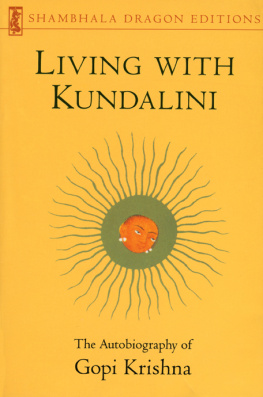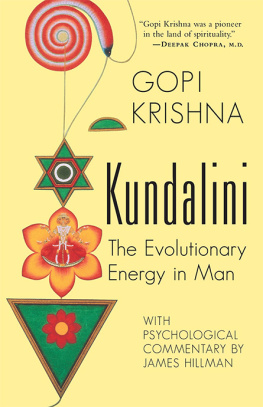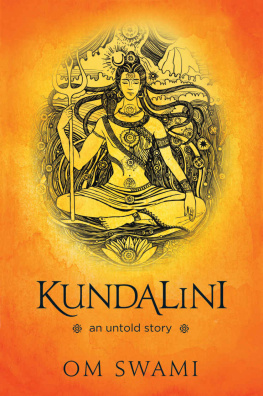The Awakening of Kundalini
by
Gopi Krishna
Published by:
The Institute for Consciousness Research
and
The Kundalini Research Foundation, Ltd.
Smashwords Edition
The Awakening of Kundalini
Copyright 1975 Gopi Krishna
This ebook is licensed for yourpersonal enjoyment only. This ebook may not be re-sold or givenaway to other people. If you would like to share this book withanother person, please purchase an additional copy for eachrecipient. If youre reading this book and did not purchase it, orit was not purchased for your use only, then please return toSmashwords.com or your favorite retailer and purchase your owncopy. Thank you for respecting the hard work of thisauthor.
First published in 1975 by:
E.P. Dutton & Co., New York, USA
Reprinted in 1976 by:
D. B. Taraporevala & Sons, Bombay, India
Reprinted 1989 & 1991 by:
F.I.N.D. Research Trust,Canada and
The Kundalini Research Foundation, Ltd., U.S.A.
Published by:
The Institute for Consciousness Research
165 Valley Crescent,
RR #4, Markdale ON,
Canada N0C 1H0
The Kundalini Research Foundation, Ltd.
86 Wallacks Drive
Stamford CT
06902 U.S.A.
International Standards Book Number:978-0-9938316-2-1
Library of Congress Catalog Card Number:74-28323
Table of Contents
Introduction
When The Awakening of Kundalini was firstpublished in 1975, the concept of Kundalini, even the word itself,was foreign to Western society. Since then, it has become morefamiliar if not more fully understood.
During the last three decades Yoga andmeditation have gained popularity as people are beginning toexpress a sincere desire for self-knowledge and an understanding ofhigher states of consciousness. Unfortunately, many have embarkedon their search without knowing the true aim of Yoga and without anunderstanding of the mechanism responsible for higher states ofconsciousnessKundalini. That is why this book is of such greatvalue. In addition to explaining the ancient concept of Kundalini,Gopi Krishna addresses and settles the issue of two extremelyimportant questions: What is the true aim of Yoga and what is thereal goal of meditation?
Explaining it at great length, Gopi Krishnapoints out that meditation is not always beneficial. He describesthe difference between passive meditation where thoughts areallowed to drift and active meditation where an alert focused stateof mind is required for the proper results:... alpha and thetastates are the very antithesis of the attentive states of mindessential for the evolution of the brain. They have their own valuefor rest, release, and relaxation but there can be no greaterblunder than to pass them off as illuminative or creative states ...
Once this initial experience subsided, GopiKrishna wondered what had happened to him. Was he hallucinating? Had he experienced the transcendental? He recalled fromhis reading the mention of a vital mechanism called Kundalini whichwhen aroused transforms normal human consciousness totranscendental states. Had he been lucky enough to succeed wheremillions of earnest seekers had failed? Thus began hislifelong study of the Kundalini experience, Yoga and higher statesof consciousness.
Gopi Krishna spent the first year after hissudden awakening trying to survive and to understand what wastaking place within his interior. During this time he sufferedgreatly both physically and mentally, as the energy was initiallyaroused in its morbid form. At times he wavered between life anddeath bearing witness to his own accelerated evolutionarytransformation. During this critical period he had no learnedscholars or teachers to guide him. He survived through the love andsupport of his family and in his own words by divinedispensation. A new and stable phase in his expanded consciousnesswas marked by the appearance of inspired writing around 1950. Thetransformation of his body and brain to allow a perception of thecosmic consciousness continued until his death in 1984.
Observing Kundalini transforming his own system,Gopi Krishna realized the importance of this experience for allhumanity. He believed that Kundalini is the evolutionary energy inman responsible for mystical experience, genius and psychicabilities and certain types of mental illness. Yet he realized thatthe phenomenon would not be taken seriously nor correctlyunderstood without a proper scientific investigation.
Gopi Krishna's view of research intoKundalini encompassed three avenues of investigation and was basedon the hypothesis that Kundalini is the psychophysiologicalmechanism responsible for human evolution and higher states ofconsciousness. These avenues of investigation are:
1) Literary Research
2) Interviews and Case Studies
3) Kundalini Experimental Project
The first phaseLiterary Researchconsists of astudy of the ancient, esoteric oral and written traditions and theinvestigation of the lives and writings of at least 25 greatmystics and geniuses. The objective of this phase is to correlatethe psychological and physiological factors responsible for theexperiences of the mystic/genius.
The second phaseInterviews and Case Studiesisto consist of interviews with medical professionals and socialworkers involved in the care and treatment of the mentallydisturbed, first-hand case studies of the same, as well as widelypublicized advertisements outlining the classical symptomsindicative of a Kundalini awakening. The objective of this phase isto acquire as much statistical data as possible from those personsexperiencing the symptoms of a Kundalini awakening. The importanceof this phase is discussed in this book in the chapter on TheDangers of Partial Awareness. Many people are undergoingspontaneous Kundalini experiences. Not knowing what is happening tothem, they often are branded as mad or permanently ruin theirhealth by not adjusting their lifestyles in the proper way.
The third phaseKundalini ExperimentalProjectis to consist in part of a Kundalini Clinic established tomonitor and provide competent guidance to those people sufferingthe purgatorial symptoms of the Kundalini awakening.
It is this scientific study that appeals to manyof us in the West. It was Gopi Krishna's interest in a scientificstudy that most appealed to me when I was first introduced to himin 1976. As a scientist I was struck by the man's sincerity andgenuine willingness to abide by the findings of a scientific study.Gopi Krishna realized the strength of science in today's world andhe also realized its importance. He understood that the public ingeneral would not accept the Kundalini hypothesis without some kindof verification. This is indeed as it should be. It is left forthose of us who are now interested in the subject to pursue thisinvestigation so that future generations will benefit not only fromself awareness but will be ripe for the greatest experienceavailable to the human mindmystical experience.
From his humble beginnings in the village ofGairoo in Kashmir in 1903, through his career as a clerk with theIndian government, Gopi Krishna experienced a transformation thatchanged his life forever.
From 1950 until his death, he wrote and lecturedconstantly trying to interest scholars and scientists in hisinvestigation.
At the age of 80, he traveled to Canada and theUnited States despite failing health. In an exhausting round oflectures and private conversations, he emphasized the urgent needto proceed with Kundalini research.
Gopi Krishna died six months later and there isno doubt in the minds of those of us who attended these lastmeetings that he gave his life to promote the knowledge ofKundalini.
Paul Pond, Ph.D.
1
What Everyone Should Know










